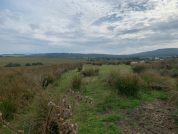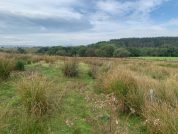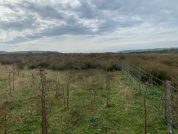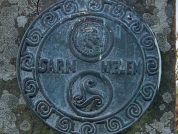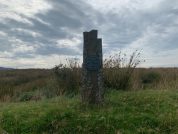Coelbren Roman Fort
Flavian Auxiliary Fort (AD 69–96)
The Roman site at Coelbren lies just south and west of the confluence of three streams, the Camnant, Nant-y-Bryn, and Nant-y-Fedwen, which together form the Afon Pyrddin and thus united pass close outside the fort’s eastern defences. The Roman road from Brecon (Cicucium or Y Gaer) in the north-east crossed the Afon Pyrddin about 520 feet (c.160 m) to the immediate east of the fort and entered through its eastern gateway.
In outline the Coelbren fort platform and its outlying defences describe an almost perfect square with rounded corners. Gateways are noted in all four sides, centrally placed to west and east, those to north and south being off-set to the east by a ratio of 3:2. The northern defences were seemingly continued straight eastwards almost to the river and those on the south likewise extended at an angle to join the river at an eastward bend in its course, together these enclosed a defended annexe roughly the same size as the fort itself; there are various other interpretations for these outworks, however, as they have not been investigated in detail.
The fort rampart was constructed of alternating layers of turf, clay and brushwood resting at the front upon a corduroy of logs set at right-angles to the line of the defences. The rampart, measuring between 25 and 26 feet (c.7.6 – 7.9 m) wide, was separated by a berm 16 feet (4.9 m) wide from its enclosing ditch system. The ditches on the north and west sides were found to be bivallate in nature, the inner ditch measuring between 9 and 11 feet wide by 7½ feet deep (c.2.8-3.4 x 2.3 m), the outer ditch being 7 to 8 feet wide by 6 feet deep (c.2.1-2.5 x 1.8 m); both were V-shaped, sported a row of pointed oak stakes in the bottom, and were separated from each other by a berm between 7 to 15 feet (c.2.1-4.6 m) in width. The enclosure measures about 440 feet east-west by 430 feet north-south (c.134 x 131 m) within the ramparts, thus giving an accommodation area of about 4½ acres (c.1.8 ha).
Excavations were conducted by Col. W.Ll. Morgan between 1904 and 1907, who sectioned the ramparts in all four corner-angles, the ditches on the south and west, and the western and eastern gateways; he also conducted limited trenching within the defences which revealed traces of internal timber buildings. Pottery finds recovered during Morgan’s explorations included pieces of amphora, mortaria and ollae, a flagon, flanged bowls, a pot lid and a ‘poppy-head’ beaker, most of which were dated to the late-1st or early-2nd centuries, although a few pieces were Hadrianic or Antonine. Other finds included five melon beads, a ballista ball, glass from both containers and windows, iron nails and a lump of fused lead. Interestingly, all Samian pottery recovered from the site has been dated to the Flavian period.
The area enclosed by these elaborate defences is easily large enough to have housed a cohors equitata, a mixed auxiliary unit comprising about 320 infantry and 120 horse-troopers, or perhaps even a cavalry ala of a nominal 500 horsemen. It must be said that the available occupation area at Coelbren would perhaps have been a little too small to comfortably house the latter type of unit, who were the Roman auxiliary elite and used to no small amount of comfort when on campaign, and on these grounds alone the former type of regiment is far more likely to have been accommodated here.
The Coelbren fort is one of five attributed by R.E.M. Wheeler to the campaigns of Sextus Julius Frontinus (c.73-78AD), the others being Brecon (Cicucium or Y Gaer), Castell Collen, Caersws and Forden Gaer. Although no clear evidence has been unearthed at Coelbren in support of Wheeler’s hypothesis, Grace Simpson points out:
The Roman military trinkets in the Seven Sisters hoard near Coelbren suggest the capture of soldiers whose equipment was taken by a British chieftain, and the Silures gave such captives as presents to other tribes.” (Simpson, p.4)
Whatever its early history, the fort was apparently evacuated sometime around A.D. 120 and it’s garrison probably posted to the new northern frontier of Hadrian’s Wall. The site was seemingly reoccupied for a short time during the Antonine period, however, as testified by unstratified Antonine pottery recovered from the fort’s interior.
It is possible that Coelbren may have been the site of the camp belonging to the unfortunate Roman auxiliary units overwhelmed and captured towards the end of Ostorius Scapula’s administration of Britain, and described in the Annals of Tacitus (vide infra), but again, the lack of evidence neither refutes nor lends any support to this theory.
Particularly marked was the obstinacy of the Silures,¹ who … accordingly cut off two auxiliary cohorts which, through the cupidity of their officers, were ravaging the country too incautiously ; and by presents of spoils and captives they were drawing into revolt the remaining tribes …” (Tacitus Annals XII.xxxix)
- The Silures tribe inhabited most of South Wales apart from the south-west peninsula (Dyfed).
Besides the marching camp nearby at Coelbren itself, there is another camp about five miles along the road to the north-east at Ystradfellte (SN9216), and two fortlets along the road to the south-west at Hirfynydd (SN8104 & SN8206).
Map References for Coelbren
References for Coelbren
- An Inventory of the Ancient Monuments in Glamorgan by the RCAHMW (HMSO, Cardiff) vol.1, part ii, pp.83/4 & fig.47;
- The Roman Frontier in Wales by V.E. Nash-Williams (Cardiff, 1969) p.124;
- Britons in the Roman Army by Dr. Grace Simpson (London, 1964);
- Air Reconnaissance in Britain, 1958-1960 by J.K. St. Joseph in J.R.S. li (1961) p.126;
- Annales by Cornelius Tacitus, translated by J.Jackson (Loeb, Harvard, 1937);
- Military Aspects of Roman Wales by Prof. F. Haverfield (London 1910) pp.97-100.
Roman Roads near Coelbren
NE (17) to Y Gaer (Brecon Gaer, Powys) SW (11) to Nidvm (Neath, West Glamorgan) Sarn Helen: SW (3.5) to Hirfynydd NE (6) to Ystradfellte
Sites near Coelbren Roman Fort
- Coelbren Camp (1 km)
Marching or Temporary Camp - Hirfynydd Ridge Fortlet (5 km)
Fortlet and Signal Station - Craig y Ddinas Hillfort (Ystradfellte) (6 km)
Iron Age Hillfort and Iron Age Promontory Hillfort - Ystradfellte Marching Camp (9 km)
Marching or Temporary Camp - Carn Caca (Melin Court Brook) Marching Camp (11 km)
Marching or Temporary Camp - Blaen-Cwmbach Marching Camp (13 km)
Marching or Temporary Camp - Arhosfa'r Garreg-lwyd (17 km)
Marching or Temporary Camp - Neath (Nidum) Roman Fort (17 km)
Flavian Auxiliary Fort (AD 69–96) and Milestone - Neath (Nido) Vicus (17 km)
Minor Settlement - Maendy Camp (18 km)
Iron Age Hillfort
